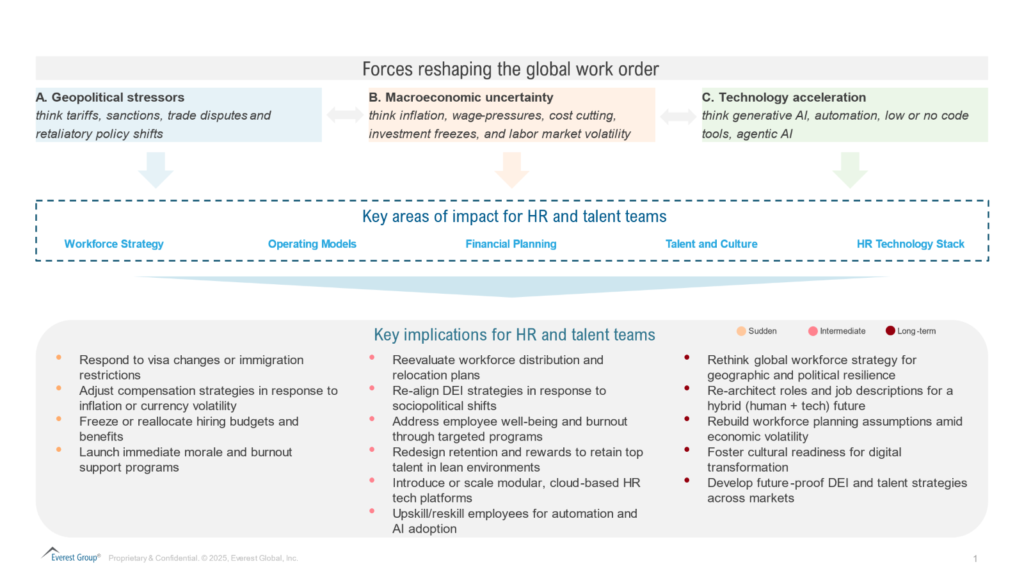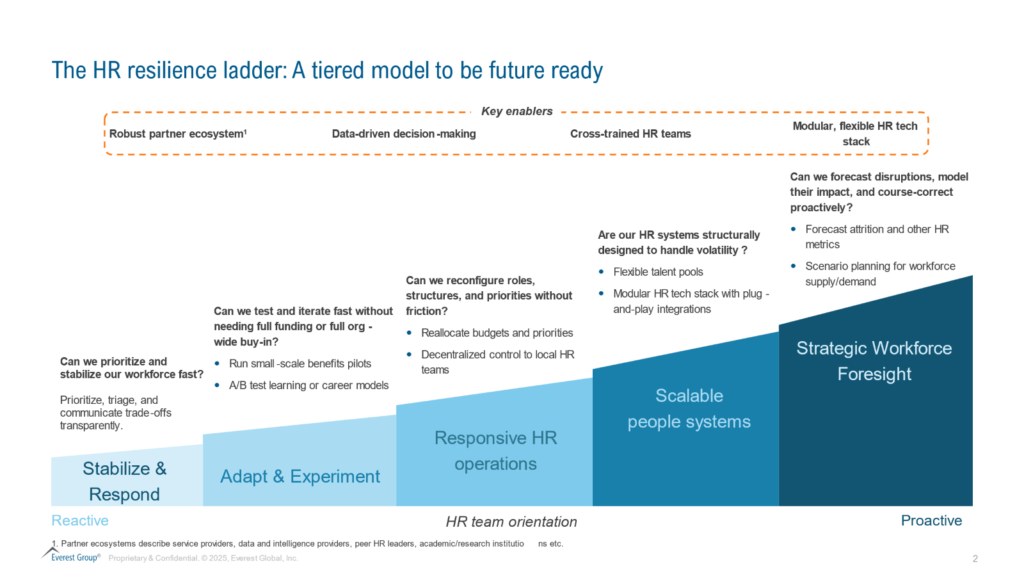True Agility in an Age of Constant Disruption: Why HR Must Build for Resilience | Blog

To the Human Resources (HR) leaders experiencing déjà vu with every new crisis, this is your reminder: you are not alone, and you are more critical than ever before, as our analysts have explained below.
Reach out to discuss this topic in depth.
The new normal is never normal
Leaders now navigate nine major organizational shake-ups every year, up from just two before 20201. The last decade has made one thing painfully clear too: disruption is no longer a deviation from the norm. It is the norm.
The world wasn’t ready for Trump’s trade war, just like it wasn’t ready for the pandemic or the artificial intelligence (AI)-fuelled tech boom now reshaping the world of work. We’ve entered a state of permacrisis, where instability is the norm and sharp, structural shocks catch us off guard. Change no longer simmers; it snaps.
And amidst it all, work keeps changing. HR leaders, more than most, are constantly forced to adapt. They’ve long been the quiet core of crisis response, realigning workforces as the world reshapes itself.
Consider the pandemic: overnight, HR teams had to pivot entire organizations to remote work, tackle a mental health crisis, and navigate the legal and logistical chaos of distributed teams. Then came the Great Resignation, exposing deep cracks in how companies retain and support talent. Add to that the ripple effects of geopolitical shifts and the relentless churn of tech redefining which skills matter and when.
HR doesn’t just absorb these hits; it rebuilds after them. Rethinking hiring, reskilling, reworking comp plans, and rewriting succession strategies. Just in time for the next disruption to land.
Disruption isn’t random. It’s relentless
Three forces fuel these constant disruptions:
- Geopolitical volatility (from war and trade policies to immigration reform): forces HR to rethink workforce models, local labor laws, and Diversity, Equity and Inclusion (DEI) strategies
- Accelerated technology cycles (such as AI, automation, and new platforms): upend job architectures, change compensation logic, and shift critical skills seemingly overnight
- Macroeconomic stressors (such as inflation, recession fears, or demographic slowdowns): create new pressure points on budgets, workforce morale, and strategic headcount planning

These three forces don’t arrive one at a time. They overlap and amplify each other, creating rolling waves of change that HR leaders must continuously absorb.
So, what does resilience mean for HR?
Resilience in the context of HR isn’t just surviving the next disruption; it’s becoming stronger because of it. It’s not about avoiding impact, but designing for recoverability, adaptability, and forward movement.
Let’s define it in HR terms:
Resilience is the capacity of an HR function to absorb disruption, adapt in real-time, and respond with clarity and confidence without derailing business continuity or employee experience.
The HR resilience ladder
To do: skim each rung and stop at the first description that feels even slightly aspirational; that’s your current level. Everything above it is tomorrow’s work.

Everest Group’s HR Resilience Ladder is a practical framework to help teams identify where they are and what comes next.
Step 1: Stabilize and respond – the minimum viable response, i.e., deliver only the essentials needed to stop damage
- You may not have perfect systems, but you have rapid decision-making loops
- You have basic continuity plans for payroll, benefits, and safety
- You have clear priorities, even if the execution isn’t always seamless
Goal: Build the ability to act, even with limited data or structure
Step 2: Adapt and experiment – run pilots to see what works when conditions are uncertain
- You experiment, adapt, and iterate in response to change.
- You can launch micro-pilots to test new hiring models, wellness programs, or other people initiatives
- You have minimum viable tools to measure short-term effectiveness
Goal: Respond to change with flexible thinking and rapid experimentation
Step 3: Responsive HR operations – follow documented playbooks without disrupting core HR services
- A cross-functional response team can be activated quickly
- You have protocols in place for known risk scenarios (e.g., remote transition, payroll localization, hiring freezes), with its owners and timelines
- Core HR services have tested backups which stay online while the response runs
Goal: Codify your response mechanisms to make agility a repeatable and scalable capability
Step 4: Scalable people systems – adjust the entire HR function quickly
- Modular and Application Programming Interface (API)-ready HR tech which allows you to add or swap tools quickly
- You have flexible talent pools (gig, perm, internal mobility), so headcount can flex without a scramble
- Contracts with external partners (RPO, BPO, SaaS) lets you add capacity/capability on demand
Goal: Let the HR ecosystem expand, shrink or pivot rebuilding systems
Step 5: Strategic foresight – spot trouble early and pivot
- You use real-time labor data and business intelligence to detect early signals of disruption
- You proactively scenario-plan and build optionality into your workforce strategy
- You influence business planning, not just respond to it
Goal: Build systems that anticipate disruption and guide strategic workforce responses before challenges escalate
Enablers of true resilience
Climbing the ladder requires more than just resources. It requires the right toolset to complement those resources. These enablers separate average teams from high-resilience HR functions:
- Robust partner ecosystems that provide capacity and capability beyond internal resources
- Data-driven decision-making that supports early intervention and confident pivots
- Cross-trained HR teams that can step into multiple roles during change
- A modular HR tech stack that can reconfigure based on emerging needs
These aren’t future goals to be attained eventually but are current necessities.
From firefighting to future-shaping
Every time disruption strikes, HR proves its worth all over again. But that’s not sustainable. You can’t keep reinventing the wheel during every crisis.
The challenge for Chief Human Resource Officers (CHROs) and HR leaders is to stop playing defence and start designing for disruption.
That means:
- Shift from scrambling after each crisis to engineering resilience into every process
- Embedding agility into your operating rhythms
- And most of all, championing a culture that sees disruption as a muscle-building moment and not a catastrophe
Final thought: The future won’t wait for you to be ready
Let’s be clear: the next disruption isn’t a matter of if, but when. Whether it’s the next AI breakthrough, a regional conflict, or an abrupt economic downturn, the ripple effects will land (once again), at HR’s doorstep.
But HR doesn’t have to wait to be tested again to prove its value.
True resilience isn’t built in the heat of crisis. It’s engineered long before the crisis hits. It’s embedded in how your teams are trained, how your systems are structured, how your data is used, and how quickly your strategy can pivot without chaos.
And this time, the goal isn’t just survival. It’s transformation.
The CHROs who thrive in this environment won’t be the ones who hold the line. They’ll be the ones who redraw it, proactively designing HR ecosystems that are flexible, intelligent, and future-aligned. They’ll build organizations where adaptability is not an exception but a constant state of readiness.
If you found this blog interesting, check out our Substantial Change As HR Becomes Data Driven And Employee-Oriented | Blog – Everest Group, which delves deeper into another topic regarding HR.
If you have any questions or want to discuss the future of HR in more depth, please contact Siya Gupta ([email protected]), Mustafa Pitolwala ([email protected]) and Priyanka Mitra ([email protected]).